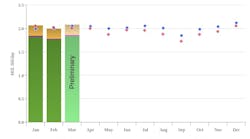Leena Koottungal
Survey Editor/News Writer
In March, Schlumberger Business Consulting (SBC), the management consultancy arm of Schlumberger, released the 2010 Oil & Gas HR Benchmark Study (OGJ Online, Mar. 29, 2011). SBC has produced the survey since 2004 to highlight best practices in talent management. For the first time in its history, this survey measures the impact of human resource strategies on production growth.
Insights from this year's survey are structured around PTP Intensity, a concept developed by SBC to show the correlation between the ratio of petrotechnical professionals (PTPs) to operated production and production growth based on the last 5 years' compound annual growth rate.
The survey was compiled by the SBC Energy Institute using data from 11 national oil companies (NOCs), 5 major oil companies, 12 independents, 1 oil field services company, and 77 universities. The contributing companies account for 30% of the world's oil production.
Big crew change
A generation of geoscientists and petroleum engineers hired before the deep recruitment cuts of the mid-1980s is approaching retirement. This "big crew change" currently is reshaping the global upstream industry and will lead to the loss of 5,000 experienced petrotechnical professionals by 2014. Higher graduate recruitment targets are too late to reverse this trend in the next 3 years.
In terms of recruitment of graduates, the demand is recovering compared to the pessimistic forecasts of 2009. Recruitment targets for technical staff in 2011 are 15% higher than levels announced in 2009. NOCs, independents, and majors all plan to intensify recruitment efforts beyond this year.
In another positive trend, universities appear on track to provide the oil and gas industry with sufficient graduates in the geosciences and petroleum engineering. However, supply from quality universities will remain tight.
Geographically, the 2010 survey reveals that Asia and Russia-CIS account for 72% of graduates in geosciences and 79% in petroleum engineering, with more than 30% attributable to China alone. Companies will need to adapt their recruitment to the new distribution of talent worldwide.
The survey revealed that most companies have increased the number of females among their PTPs, but the ratio is well below the percentages achieved in universities. North American universities reported female ratios well below other regions like Asia and Latin America.
In Asia, more than 40% of graduates are women. However, North American universities hardly reach 20% of females among PTP graduates.
Generally, the number of female PTPs in E&P companies has increased since 2006. In NOCs, female ratios have risen to 27% from 19% in geosciences and to 17% from 15% in petroleum engineering. Independent companies show the same increasing trend with female PTPs in geosciences at 22% from 18% previously and 14% from 12% in petroleum engineering.
Female ratios remain unchanged at the major companies at 17% in geosciences and 10% in petroleum engineering. For exploration and production companies, female ratios vary from 15% to 27% depending on discipline.
Predicted outcomes, impact
The availability of experienced PTPs is expected to decline over the next 4 years leading to project delays, increased risks, and salary inflation.
Along with the shortage of experienced PTPs in the coming years, recent trends and serious accidents could lead to higher costs and a generally higher PTP Intensity industry-wide.
Deepwater projects are being subjected to stricter regulations, which may spread beyond deepwater operations. Standards will be upgraded in environmental, permit, drilling, production, and blowout containment and spill response.
Technology is critical to deepwater drilling success and to the development of unconventional oil and gas resources. It will provide opportunities for a competitive advantage. Safety assurance will constantly be tested and upgraded.
In this context, companies need to adapt quickly to manage their talent pools to accommodate growth and changes to the regulatory environment or risk losing their competitive advantage. Companies should improve processes, provide adequate management systems, and incorporate new values and behavior. The talent gap might just contribute to some companies losing their licenses to operate.
More Oil & Gas Journal Current Issue Articles
More Oil & Gas Journal Archives Issue Articles
View Oil and Gas Articles on PennEnergy.com
